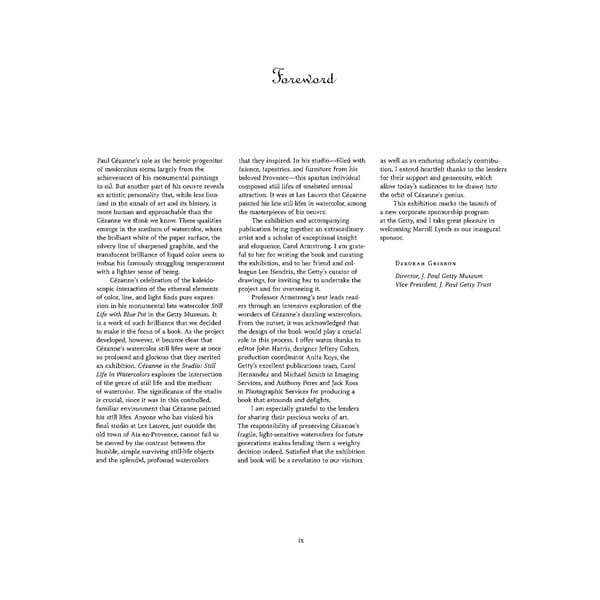Foreword Paul Cezanne's role as the heroic progenitor that they inspired. In his studio—filled with as well as an enduring scholarly contribu- of modernism stems largely from the faience, tapestries, and furniture from his tion, I extend heartfelt thanks to the lenders achievement of his monumental paintings beloved Provence—this spartan individual for their support and generosity, which in oil. But another part of his oeuvre reveals composed still lifes of unabated sensual allow today's audiences to be drawn into an artistic personality that, while less lion- attraction. It was at Les Lauves that Cezanne the orbit of Cezanne's genius. ized in the annals of art and its history, is painted his late still lifes in watercolor, among This exhibition marks the launch of more human and approachable than the the masterpieces of his oeuvre. a new corporate sponsorship program Cezanne we think we know These qualities The exhibition and accompanying at the Getty, and I take great pleasure in emerge in the medium of watercolor, where publication bring together an extraordinary welcoming Merrill Lynch as our inaugural the brilliant white of the paper surface, the artist and a scholar of exceptional insight sponsor. silvery line of sharpened graphite, and the and eloquence, Carol Armstrong. I am grate- translucent brilliance of liquid color seem to ful to her for writing the book and curating imbue his famously struggling temperament the exhibition, and to her friend and col- DEBORAH GRIBBON with a lighter sense of being. league Lee Hendrix, the Getty's curator of Director, J. Paul Getty Museum Cezanne's celebration of the kaleido- drawings, for inviting her to undertake the Vice President, J. Paul Getty Trust scopic interaction of the ethereal elements project and for overseeing it. of color, line, and light finds pure expres- Professor Armstrong's text leads read- sion in his monumental late watercolor Still ers through an intensive exploration of the Life with Blue Pot in the Getty Museum. It wonders of Cezanne's dazzling watercolors. is a work of such brilliance that we decided From the outset, it was acknowledged that to make it the focus of a book. As the project the design of the book would play a crucial developed, however, it became clear that role in this process. I offer warm thanks to Cezanne's watercolor still lifes were at once editor John Harris, designer Jeffrey Cohen, so profound and glorious that they merited production coordinator Anita Keys, the an exhibition. Cezanne in the Studio: Still Getty's excellent publications team, Carol Life in Watercolors explores the intersection Hernandez and Michael Smith in Imaging of the genre of still life-and the medium Services, and Anthony Peres and Jack Ross of watercolor. The significance of the studio in Photographic Services for producing a is crucial, since it was in this controlled, book that astounds and delights. familiar environment that Cezanne painted I am especially grateful to the lenders his still lifes. Anyone who has visited his for sharing their precious works of art. final studio at Les Lauves, just outside the The responsibility of preserving Cezanne's old town of Aix-en-Provence, cannot fail to fragile, light-sensitive watercolors for future be moved by the contrast between the generations makes lending them a weighty humble, simple surviving still-life objects decision indeed. Satisfied that the exhibition and the splendid, profound watercolors and book will be a revelation to our visitors IX
 Cézanne in the Studio: Still Life in Watercolors Page 11 Page 13
Cézanne in the Studio: Still Life in Watercolors Page 11 Page 13